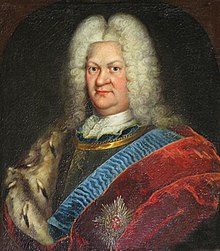Friedrich Wilhelm I (Mecklenburg)
Friedrich Wilhelm (I.), Duke of Mecklenburg [-Schwerin] (born March 28, 1675 in Grabow ; † July 31, 1713 in Mainz ) was the ruling Duke of Mecklenburg in the Mecklenburg-Schwerin region from 1692 to 1713.
Life
Friedrich Wilhelm was born as the eldest son of Prince Friedrich (1638–1688) and Christine Wilhelmine von Hessen-Homburg (1653–1722) and was a nephew of the childless Duke Christian Ludwig I. He married Sophie Charlotte in Kassel on January 2, 1704 von Hessen-Kassel (born July 16, 1678 - † May 30, 1749 in Bützow), daughter of Landgrave Karl von Hessen-Kassel . The connection remained childless.
Friedrich Wilhelm died on his return from Schlangenbad near Mainz on July 31, 1713. His wife Sofia Charlotte took her widow's seat in Bützow , where she also died. She was buried next to her husband in the crypt of the Nikolaikirche in Schwerin, which he had recently built .
Act
On June 21, 1692, Friedrich Wilhelm succeeded his uncle as regent of the Schwerin part of the country. After the Güstrow line of the Mecklenburg dynasty died out, he and his uncle Adolf Friedrich fought a violent dynastic succession dispute, which quickly escalated, brought the country to the brink of civil war and could only be settled through the intervention of foreign powers. The dispute ended in 1701 with the Hamburg settlement , which again split Mecklenburg into two limited autonomous parts of the country, the two partial principalities of Mecklenburg-Strelitz and Mecklenburg-Schwerin, which existed until 1918 , as well as the right of succession of the firstborn for the dynasty.
In 1708 Friedrich Wilhelm introduced the Consumption and Tax Regulations to overcome the consequences of the war, both of the Thirty Years' War and the Northern War . In addition to the taxation of the knighthood and the clergy, the consumption and tax regulations included the abolition of the peasants' bondage dependence on their landlords. The peasants' bondage was to be converted into a long lease, and forced labor was to be replaced by cash benefits. This created a sharp contrast between the duke and the estates.
progeny
Friedrich Wilhelm had numerous mistresses with whom he fathered at least nine illegitimate children, including:
- Margaretha Dorothea Greler (* 1694 in Doberan, † 1744 in Dömitz)
- Carl Ludwig von Mecklenburg (1694–1752) on Zibühl, Lübzin and Karcheez (son with Sophie Magdalene von Plüskow , † 1703); ⚭ 1724 Sophia Charlotte von Bergholtz (1705–1742)
- Friedrich Wilhelm of Mecklenburg; ⚭ 1724 Magdalena Louisa von Moltzahn (1695–1732)
- Friedrich Wilhelm Streit (* 1700)
- Friederica Wilhelmina von Mecklenburg (* 1702 in Bahlen near Boizenburg , † 1748 in Schwerin ); ⚭ 1719 Hermann Christian von Wolffradt († 1723 in Dömitz )
- Friederica Louisa of Mecklenburg (* 1703); ⚭ 1724 Erasmus Heinrich Schneider von Weissmantel
- Friedrich Wilhelm (* 1703)
- Carl Christian of Mecklenburg
Margaretha Dorothea and Friederica Wilhelmina were later mistresses of Duke Karl Leopold .
literature
- Ludwig Fromm: Friedrich Wilhelm, Duke of Mecklenburg-Schwerin . In: Allgemeine Deutsche Biographie (ADB). Volume 7, Duncker & Humblot, Leipzig 1877, p. 557 f.
Web links
Individual evidence
- ↑ Duke Friedrich Wilhelm (I.) appears in the dynastic count of the regents of Mecklenburg almost without counting. This is fundamentally wrong, as there was another regent of the same name in Mecklenburg after him, Friedrich Wilhelm (II.) , And the dynasty continued to count unimpressed by the more recent main division of states and the increase in rank in 1815. In both cases, the widespread error in Wikipedia has been fixed, the count in parentheses has been added and taken into account in the lemma.
- ^ Friedrich Wigger : Family tables of the Grand Ducal House of Meklenburg. In: Yearbooks of the Association for Mecklenburg History and Archeology 50 (1885), p. 111 ff. ( Digitized version )
- ^ A b c d e Corinna Schulz: Of bastards and natural children: The illegitimate offspring of the Mecklenburg dukes 1600-1830. Böhlau, Weimar 2015, ISBN 978-3-412-22425-7 , p. 274 f.
- ^ Descendants http://jennus.beepworld.de/brandenstein.htm
- ^ Admission into the Mecklenburg nobility as "v. Mecklenburg" on November 6, 1742); Descendants are the noble family of Mecklenburg in the Mecklenburg , Swedish and Prussian nobility; later Prussian baron class (Freiherr Heinrich von Mecklenburg (* 1871; † 1862) (cf. Goth. adel. Tschenb. B. 1916, 1925 (family line) and 1942, Genealogical manual of the nobility , noble houses B, volume III, complete series volume 17, 1958, pp. 312-316 first half page)
- ^ Corinna Schulz: Of bastards and natural children: The illegitimate offspring of the Mecklenburg dukes 1600-1830. Böhlau, Weimar 2015, p. 121 ff, p. 171.
- ↑ The marriage was arranged by Duke Carl Leopold. He also provided the bridal treasure in the amount of 13,000 Reichstalers. see. Corinna Schulz: Of bastards and natural children: the illegitimate offspring of the Mecklenburg dukes 1600-1830. Böhlau, Weimar 2015, p. 274 f.
- ↑ Their ancestry is controversial in the literature; In addition to the Mecklenburg Duke, authors also name the Prussian "Soldier King", Friedrich Wilhelm I, as their father. Nothing has been known (so far) about their recognition or ennoblement .
- ↑ Friederica Wilhelmina was brought to the Schwerin court by her father in 1711. see. Corinna Schulz: Of bastards and natural children: the illegitimate offspring of the Mecklenburg dukes 1600-1830. Böhlau, Weimar 2015, p. 274.
| predecessor | Office | successor |
|---|---|---|
| Christian Ludwig I. |
Duke of Mecklenburg [-Schwerin] 1692–1713 |
Karl Leopold |
| personal data | |
|---|---|
| SURNAME | Friedrich Wilhelm I. |
| ALTERNATIVE NAMES | Mecklenburg, Friedrich Wilhelm I. von (wrong name form) |
| BRIEF DESCRIPTION | Duke of Mecklenburg in the Mecklenburg-Schwerin region |
| DATE OF BIRTH | March 28, 1675 |
| PLACE OF BIRTH | Grabow |
| DATE OF DEATH | July 31, 1713 |
| Place of death | Mainz |
